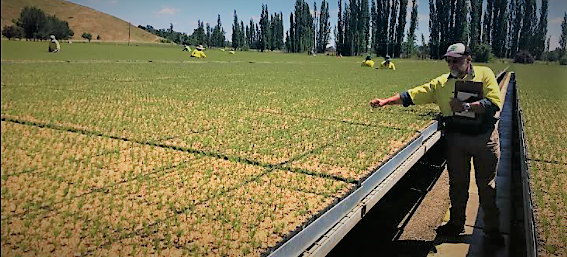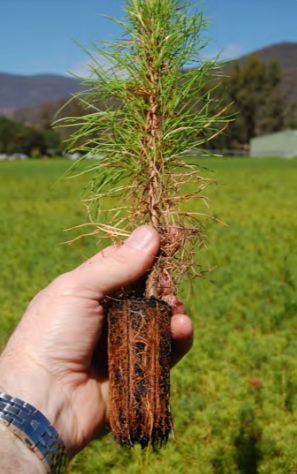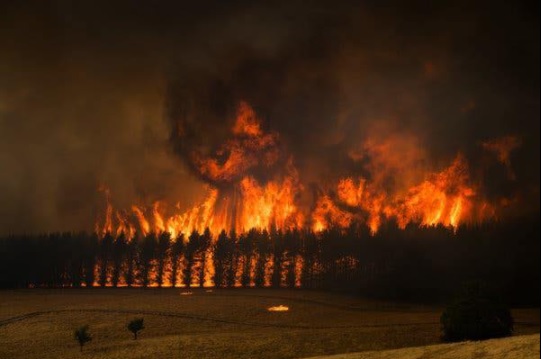
Blowering Nursery staff have sown around 300,000 seeds a day to supply the 2022 planting program fro Forestry Corporation of NSW. Photo: Forestry Corporation of NSW.
On the back of a record 2021 planting season, Forestry Corporation of NSW’s 2022 seedling crop is well and truly underway with 11 million radiata pine (Pinus radiata) sown in the organisation’s Blowering Nursery, near Tumut.
Forestry Corporation of NSW plantation improvement manager Phil Green said during the past eight weeks, nursery staff have sown around 300,000 seeds a day to supply the 2022 planting program.
“The process starts in September and moves through cycles of seed stratification, sowing, crop tending, topping, consolidation, and ultimately dispatch in the winter months between May and September,” he explained.
All up, 430kg of seed were sown at the Blowering Nursery this year for the 2022 forestry planting program.

The new radiata pine seedling crop at Blowering Nursery will be carefully hand-weeded, fertilised, nurtured and watered to produce seedlings in time for planting next winter. Photo: Forestry Corporation of NSW.
“We’ve dispatched more than 70 million containerised seedlings from Blowering nursery during the past 10 years, which have ultimately helped build people’s homes and vital infrastructure,” said Mr Green.
This year, 16 million pine and hardwood seedlings were hand-planted, a record effort to rebuild state plantation forests lost in the Black Summer bushfires and previously harvested areas.
Forestry Corporation of NSW strategy and risk manager Gavin Jeffries said last winter’s 14,000 hectare record softwood planting was an important milestone in the organisation’s bushfire recovery program, but it was not without its challenges.
“With around one-third of state forest plantations affected by the 2019-2020 fire season, we’ve expanded and fast-tracked our nursery programs in time for a record 2021 season,” he said.
“As seedlings needed to be hand-planted, this year also presented a series of issues connected to COVID-19 restrictions and our contractors securing workers on the ground.
“Fortunately we’ve been able to work through these and adapt, even planting an additional 1300 hectares than planned due to the high seedling quality this year.”
These trees will grow for around 30 years before being harvested for renewable timber products such as timber framing, kitchens and flooring.
Forestry Corporation of NSW Snowy regional manager Dean Anderson said the past 18 months have seen a massive effort by the organisation’s staff and contractors to recover from the impacts of the Black Summer bushfires.
“Not only have we seen a record replanting program successfully implemented, our teams have also salvaged more than three million tonnes of fire-affected timber and implemented a $1.63 million upgrade to increase seedling production capacity in our Blowering Nursery,” he said.
“While there will still be challenges ahead, the industry remains positive and focused on the future.”
The 2021 seedling crop was predominantly grown in Forestry Corporation’s Tumut and Grafton production nurseries (12 million seedlings) following upgrades in 2020.

More than five million hectares of NSW was impacted by 2019-2020 Black Summer bushfires across national parks, state forests and private property. Photo: Supplied.
The remaining 3.8 million seedlings were grown under contract with other nurseries in Narromine and Colac.
Forestry Corporation’s nursery upgrades were funded through a $46 million equity injection from the NSW Government, and part of the larger $100 million COVID-19 stimulus package, designed to directly stimulate economies in regional NSW.
During the coming year, the new seedling crop will be carefully hand-weeded, fertilised, nurtured and watered to produce seedlings in time for planting next winter.
“Our nursery staff will also regularly sample the stem diameter, height and nutrient status of seedlings throughout the nursery before being individually assessed to make sure they meet our high standards,” said Mr Green.
“The seedlings we plant today will grow into the trees that are used in paper, packaging, new houses, home extensions and backyard fences when the plantations are harvested 15 to 35 years from now.
“It is exciting to see it start with one tiny seed.”
Original Article published by Edwina Mason on About Regional.












